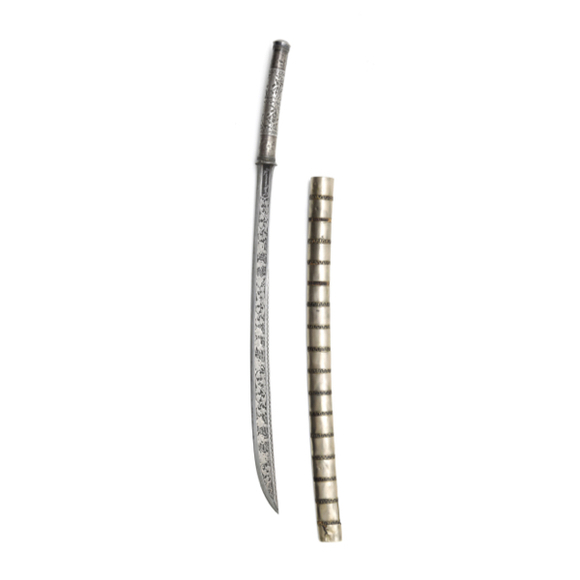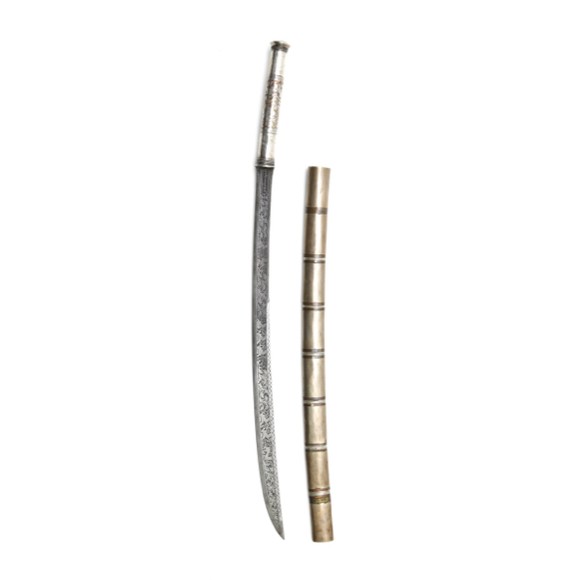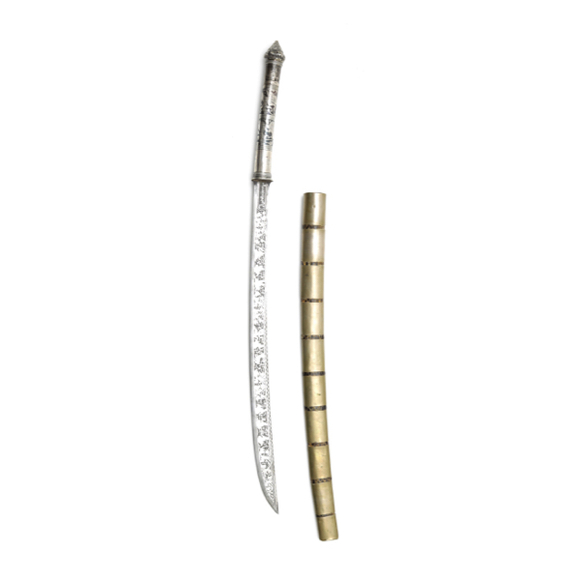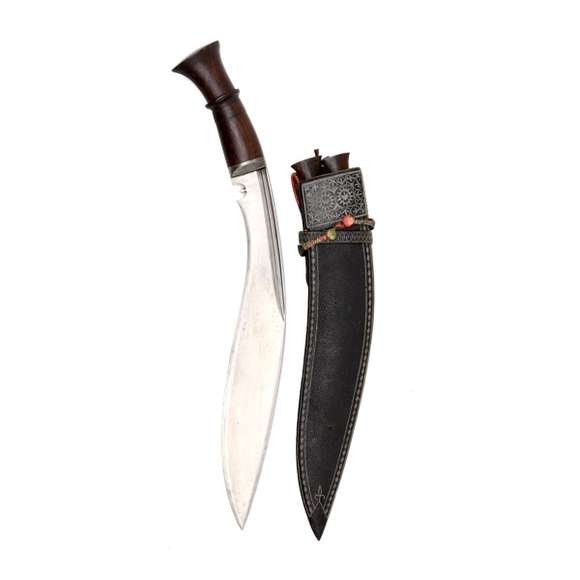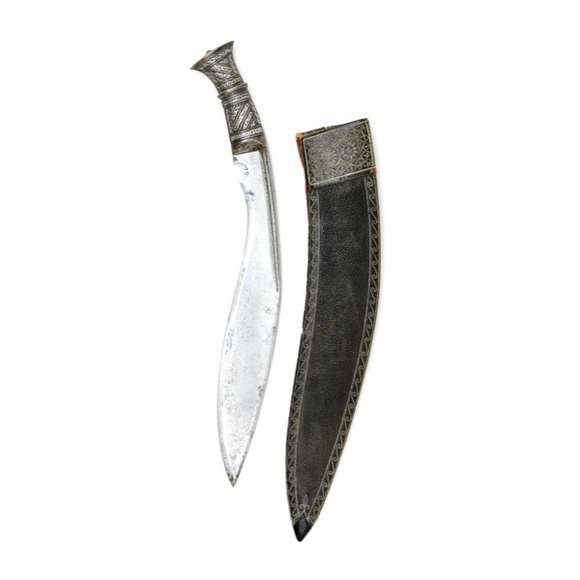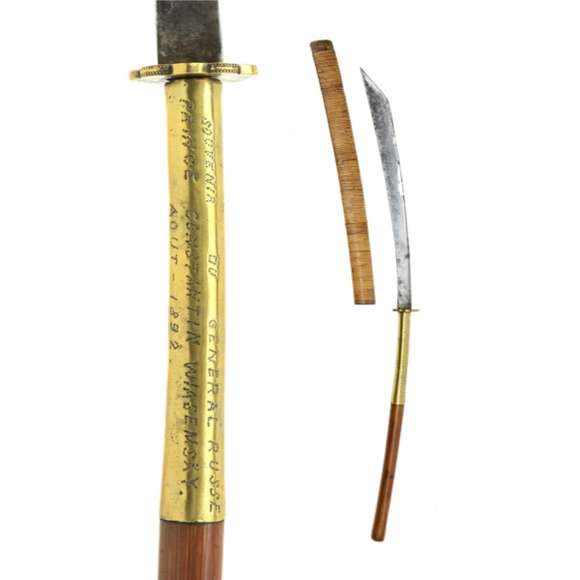With silver overlay on iron even continued on its hilt.

89.5 cm
62.7 cm
Base 10 mm
Middle 5.5 mm
5 cm from tip 4.5 mm
Narrowest at base 26 mm
Widest near tip 34 mm
723 grams
14.7 cm from hilt
Iron, steel, wood, silver, resin, copper
Mindan village, Burma
Aalderink Oriental Art, Amsterdam
Introduction
Fine silver overlaid dha made in Mindan village, south of Mandalay, gained fame in the 19th century.
"Another artistic development has its home in Mindan Village, Yamethin District, where every household depends more or less on its smithy, though there are only a few professors of the particular art to be described, which consists of an inlay of silver wire upon an iron surface. The usual articles produced are ornamental dalwes or da-hmyaungs, scissors, ..."
-E.N. Bell
A Monograph on Iron and Steel Work in Burma
Rangoon, Superintendent, Government Printing Burma, 1907
This example
The textbook blade has a long back bevel on which a meandering zig-zag line is applied. Under that, a shallow fuller with cross-hatching over which the scenes of a story are overlaid in silver.
At first sight, it's a typical example, but close examination shows the overlay is of much better quality than normally encountered. In my nearly 20 years in this business, I have seen my fair share of fine Burmese dha blades. This is so far the finest in terms of execution of the silverwork I have seen so far.
The skill continues into the hilt, with copper bands alternating with fine silver wire inlays in resin. The center section shows six figures in two tiers in silver with niello inlays, again much finer work than normally seen.
A nicely crafted bud-shaped pommel completes this fine sword.

Similarities to Saya Pyo's work
The work on the blade and the pommel bear a striking resemblance to the work of Sya Pyo, whose father was interviewed by Bell:
"This industry is said to have had its origin five generations before Saya whose son Saya Pyo, the chief local artist, turned out the articles shown in the illustrations. The originator's name is forgotten, but the art is traditional, from father to son, each improving on his ancestors, as Saya Lan himself said:
"I was better than my father, and now my son, Maung Pyo, is better than I ever was."
-E.N. Bell, 1907
Illustrations from the Bell monograph:

The story
The story on this sword blade is that of Yama Zatdaw, the Burmese version of the Ramayana, the Indian epic where Rama and his brother set out to rescue Rama’s wife Sita, who has been abducted by the evil king Ravana.
Translation of the blade inscriptions:
Right side:
သီဒါ၊ ဘီလူးရသေ့၊ သီဒါကိုဘီလူးကဆွဲခေါ်ပုံ
“Sita : The Ogre Hermit : the Ogre dragged Sita”
ရထားတင်ခေါ်ပုံ
“Taken by chariot”
ရာမ လက္ခန ၊ ဂန္ဘီမ
“Rama, Laksmana and Ghambi (Shurpanakha)"
သုကျိတ် ဘာလီ
"Sugriva and Baali (Vali)"
ဘာလီ
“Baali(Vali)"
Left side:
ဘာလီ ၊ ရာမ လက္ခန
"Baali(Vali) , Rama and Laksmana"
သုကျိပ် ဘာလီ ၊ ရာမ လက္ခန
"Sugriva, Baali, Rama and Laksmana"
ဘီလူး ၊ ရာမမင်း လက္ခန
"The Ogre, King Rama and Laksmana"
ရာမမင်း ၊ သီဒါ ၊ လက္ခန
"King Rama, Sita and Laksmana"
Notes
1. Translations by Zaw Myint Aung.





















Fine silver overlaid dha made in Mindan village, south of Mandalay, gained fame in the 19th…
An understated, elegant khukuri of substantial proportions with fine layered blade.
With iron, silver overlaid hilt. Its associated scabbard features fine quillwork.
Collected by a Russian prince from the hill peoples of central Vietnam in 1892.

